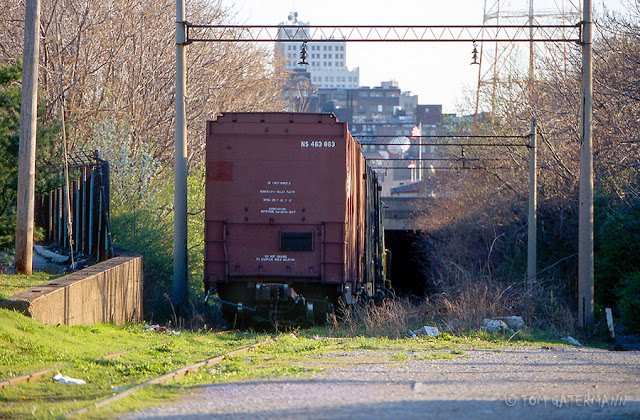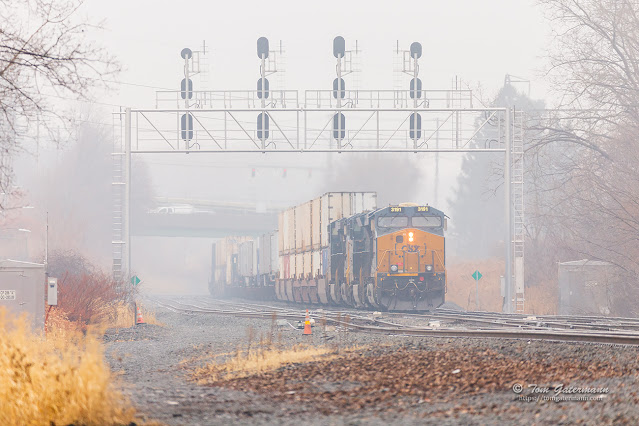RSM Newsprint Train - Illinois Terminal Highline Bridge
In the spring of 2004, I came across Railroad Switching Service of Missouri's (RSM) newsprint train, which delivered boxcars of newsprint to the St. Louis Post Dispatch in downtown St. Louis. This switching operation utilized the Illinois Terminal's (ITS) former Highline Bridge in North St. Louis, as well as the former ITS subway tunnel under the northern edge of downtown. I was lucky to come across this operation and capture the few images that I did because a few months after I took these images, the delivery of newsprint to the St. Louis Post Dispatch ended in June 2004. I was able to photograph the newsprint delivery operation on a couple of different days, but the following photographs are from only one of those days.
 |
| RSM 2020 South of Branch Street |
In the first image, above, RSM 2020 (sometimes referred to as RSSM 2020) shoves a pair of empty boxcars south from Branch Street. The crew would set out the empty boxcars at the southern end of this small rail yard, and then pickup the loaded boxcars of newsprint that were destined for the St. Louis Post Dispatch. The loaded boxcars are in the distance on the left track of this two track rail yard.
On the far left side of the above image, the approach to the old ITS Highline Bridge can be seen. Originally, the ITS was an electrified railroad, and the old catenary supports can still be seen along the line from the McKinley Bridge to the subway tunnel entrance at Cass Avenue. Though, only one track existed on the bridge at the time these photographs were taken, the bridge originally had two tracks, except, for a short section of the bridge over Interstate 70 (I-70).
 |
| RSM 2020 - Approach to the McKinley Bridge |
After picking up the two loaded boxcars of newsprint, RSM 2020 makes a back-up move up the old ITS approach to the McKinley Bridge. After backing up the approach a short distance, past the switch, the train would then pull forward down the track on the right side of the photograph to head to the Highline Bridge over north St. Louis. In this photograph that I took in 2008, you can see the approach during its conversion into a walking/biking trail. By 2008, all of the rail on the Highline Bridge and the approaches had been removed.
 |
| RSM 2020 on the Highline Bridge |
Now on the Highline Bridge, the train is rounding the curve near North 9th Street, between North Market Street and Monroe Street. The tractor trailers seen here are on the property of Duke Manufacturing. The bridge crosses over a number of business properties in north St. Louis. The bridge originally allowed ITS passenger trains to gain access to the ITS train station in downtown St. Louis. The station was in the old St. Louis Globe-Democrat newspaper building at 710 North Tucker Boulevard. In 2012, I took a photograph from almost the same spot as this image, but the photograph shows a wider view of the bridge.
 |
| RSM 2020 along I-70 |
After rolling through the curve at North 9th Street and Monroe Street, the train is rolling along side Interstate 70, at the intersection of Chambers Street and North 10th street. In the upper right corner of the photograph the Moon is visible. The block signal on the far left of the bridge is the block signal that you can see in the photograph (linked to above) that I took in 2012.
 |
| RSM 2020 crossing I-70 |
Above, the train is crossing over I-70, as traffic on the eastbound lanes into downtown starts to back up. This portion of the bridge over I-70 is the only segment of bridge that was built for single track. However, this portion looks to be newer than the rest of the bridge, and was probably built when I-70 was built.
 |
| RSM 2020 passing under the old catenary supports at Hadley Street |
 |
| RSM 2020 at Hadley and Howard Streets |
In the above two photographs, RSM 2020 and its train have left the Illinois Terminal Highline Bridge, and are coming down to grade at the intersection of Hadley Street and Howard Street. At this point, the train will be entering the trackage on Hadley Street, for a short run to the tunnel entrance just south of Cass Avenue.
 |
| Street tracks on Hadley Street |
Above, the newsprint train rolls south down Hadley Street, toward Cass Avenue, on a short section of street trackage. This image is looking south from the intersection of Hadley Street and Howard Street. Cass Avenue, where the street trackage ends, is just in front of the street light in front of the train.
 |
| Into the old ITS subway tunnel |
In the last image of this series, the train has crossed over Cass Avenue and is heading down toward the entrance to the old ITS tunnel under northern edge of downtown St. Louis. The tunnel ran from this entrance at Cass Avenue to the old St. Louis Globe-Democrat newspaper building. As mentioned earlier, the old Globe-Democrat building was originally the ITS passenger station in downtown St. Louis. The St. Louis Post Dispatch building is a couple of blocks north of the old Globe/IT station building.
According to a comment written by one of the train's crew members on January 18, 2013, at this link (the link doesn't always work), the last newsprint train operated in June 2004. But, the last train movement over the rail line was when the locomotive, RSM 2020, was sold off in 2006, and it was moved from its storage location under Tucker Boulevard, at the basement loading dock of the Post Dispatch building.
Overall, the entire length of the ITS Highline bridge is just about
4,500 feet. If you include the approaches to the bridge from Branch
Street (on the north end) and Hadley Street (on the south end), the length is just about a mile (according to
measurements taken on Google Maps). The Highline Bridge (sometimes also referred to as "Iron Horse
Trestle") was built in 1930 for the Illinois Traction
System (ITS), later know as the Illinois Terminal System (ITC). Colloquially the railroad is called the Illinois Terminal.
The IT used the bridge to get passenger and freight trains between the
McKinley Bridge at Branch Street and downtown St. Louis.
Since being built, the bridge has been owned by number of railroads and is now owned by a trail organization. The Illinois Terminal was merged into the Norfolk and Western Railway (NW), and then
into the Norfolk Southern Railway (NS), when the NW and Southern Railway
merged. Eventually, NS sold off the line to Iron Horse Resources, Inc. which operated the line under the RSM subsidiary. In 2005, the Great Rivers Greenway organization bought the Highline Bridge with plans to eventually convert it into a trail.
External links with more information:
Here is a video (on YouTube) that was shot of the RSM operation over the line, taken in 2002. In the beginning of another video (also on YouTube) you can see the Illinois Terminal operations in the Subway, on Hadley Street, on the Highline Bridge, and on the McKinley Bridge.
At this link, you can see some photos taken inside the tunnel.
Note: While the locomotive has the initials RSSM on its sides, the American Association of Railroads reporting mark for Railroad Switching Services of Missouri is RSM.
All of these images were captured on 35mm transparency film, and scanned in 2004, on a Nikon Super CoolScan 9000 ED.
Post updated 2019-Oct.-18 - Added link to tunnel photos on the bog, Irrational Ecstasy.
Post updated 2019-Oct.-16 - Added info about RSM 2020's last run over the Highline.
Post updated 2019-Oct.-16 - Added two YouTube video links.
Post updated 2019-Oct.-14 - Added additional information about the Highline Bridge being built, its length, and ownership.
External links with more information:
Here is a video (on YouTube) that was shot of the RSM operation over the line, taken in 2002. In the beginning of another video (also on YouTube) you can see the Illinois Terminal operations in the Subway, on Hadley Street, on the Highline Bridge, and on the McKinley Bridge.
At this link, you can see some photos taken inside the tunnel.
Note: While the locomotive has the initials RSSM on its sides, the American Association of Railroads reporting mark for Railroad Switching Services of Missouri is RSM.
All of these images were captured on 35mm transparency film, and scanned in 2004, on a Nikon Super CoolScan 9000 ED.
Post updated 2019-Oct.-18 - Added link to tunnel photos on the bog, Irrational Ecstasy.
Post updated 2019-Oct.-16 - Added info about RSM 2020's last run over the Highline.
Post updated 2019-Oct.-16 - Added two YouTube video links.
Post updated 2019-Oct.-14 - Added additional information about the Highline Bridge being built, its length, and ownership.




Those tracks in the last picture as it entered the tunnel sure don't look like they get used much!. Maybe by just this one train??
ReplyDeleteJim, indeed, the newsprint delivery train was the only train that was using this line at the time. However, I am not sure how often the train ran. I think it was only a couple of times a week, at most, but I'm not positive on that.
DeleteGreat images to remember this operation with. Good that you were able to capture them all and document it before it ended. I find it amazing how quickly it goes from total city to wooded area. That tunnel looks interesting. I love tunnels. :-) Great history post and thanks for all the details
ReplyDeleteThanks a lot, Shelly. I'm glad I was able to capture this rail switching operation a couple of times. Especially, since it ended shortly after. I would have loved to have been able to go into that tunnel and see what it was like. However, for various reasons, it wouldn't really have been safe to do.
DeleteI was also able to photograph the K.C. Star having newsprint delivered by rail in 2005. I need to rework most of those as well and post them. Glad to have caught the KC operation as well since it ended shortly after I photograph it. I'm beginning to think I'm bad luck for trains that deliver newsprint.
Shelly, you should check out this link for some photographs taken inside the tunnel. https://irrationalecstasy.blogspot.com/2006/01/illinois-terminal-railroad-tunnel.html. I came across this site years ago, but only just remembered it.
Delete